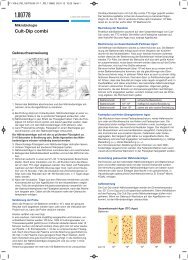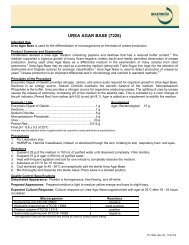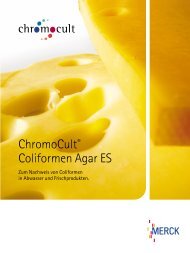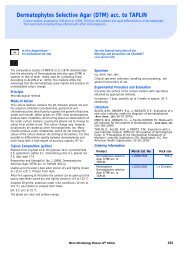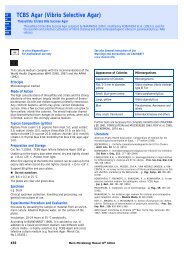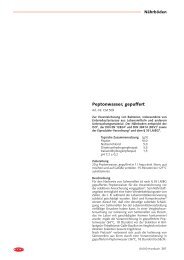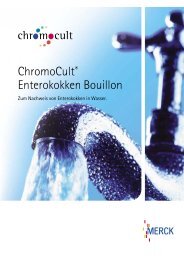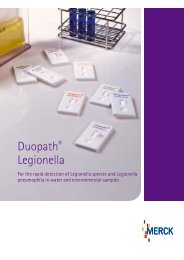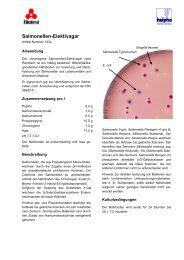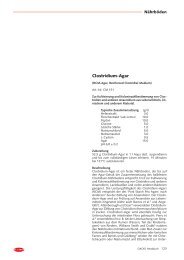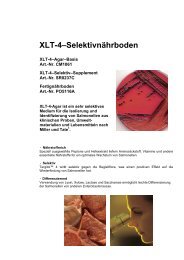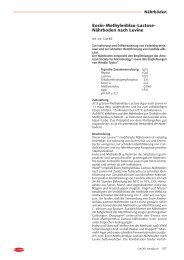SELENITE CYSTINE BROTH (7283) - mibius
SELENITE CYSTINE BROTH (7283) - mibius
SELENITE CYSTINE BROTH (7283) - mibius
Create successful ePaper yourself
Turn your PDF publications into a flip-book with our unique Google optimized e-Paper software.
TRIPLE SUGAR IRON AGAR (7162)<br />
Intended Use<br />
Triple Sugar Iron Agar is used for the differentiation of microorganisms on the basis of dextrose, lactose, and sucrose<br />
fermentation and hydrogen sulfide production.<br />
Product Summary and Explanation<br />
In 1911, Russell described the use of two sugars in a medium to differentiate Gram-negative organisms of intestinal<br />
origin. 1 Lead or iron salts were added to Russell’s medium to detect the presence of hydrogen sulfide. Kligler added lead<br />
acetate to Russell Double Sugar Agar, resulting in a medium capable of differentiating typhoid, paratyphoid, and<br />
dysentery. 2,3 A modification of this medium was developed, Kligler Iron Agar, using Phenol Red as an indicator and iron<br />
salts to detect hydrogen sulfide production. In 1940, Sulkin and Willett described a triple sugar ferrous sulfate medium for<br />
use in identification of enteric organisms. 4 Triple Sugar Iron Agar is essentially the formula originally described by Sulkin<br />
and Willett. 4<br />
Triple Sugar Iron Agar is recommended for differentiation of enteric, Gram-negative bacilli from clinical specimens, dairy<br />
samples, and food products. 5-7<br />
Principles of the Procedure<br />
Enzymatic Digest of Casein, Enzymatic Digest of Animal Tissue, and Yeast Enriched Peptone provide the nitrogen,<br />
carbon, and vitamins required for organism growth. Triple Sugar Iron Agar contains three carbohydrates, Dextrose,<br />
Lactose and Sucrose. When the carbohydrates are fermented, acid production is detected by the Phenol Red pH<br />
indicator. Sodium Thiosulfate is reduced to hydrogen sulfide, and hydrogen sulfide reacts with an iron salt yielding the<br />
typical black iron sulfide. Ferric Ammonium Citrate is the hydrogen sulfide (H 2 S) indicator. Sodium Chloride maintains the<br />
osmotic balance of the medium. Agar is the solidifying agent.<br />
Formula / Liter<br />
Enzymatic Digest of Casein ......................................................5 g<br />
Enzymatic Digest of Animal Tissue...........................................5 g<br />
Yeast Enriched Peptone .........................................................10 g<br />
Dextrose....................................................................................1 g<br />
Lactose....................................................................................10 g<br />
Sucrose ...................................................................................10 g<br />
Ferric Ammonium Citrate .......................................................0.2 g<br />
Sodium Chloride........................................................................5 g<br />
Sodium Thiosulfate ................................................................0.3 g<br />
Phenol Red ........................................................................0.025 g<br />
Agar......................................................................................13.5 g<br />
Final pH: 7.3 ± 0.2 at 25°C<br />
Formula may be adjusted and/or supplemented as required to meet performance specifications.<br />
Precautions<br />
1. For Laboratory Use.<br />
2. IRRITANT. Irritating to eyes, respiratory system, and skin.<br />
Directions<br />
1. Suspend 60 g of the medium in one liter of purified water.<br />
3. Heat with frequent agitation and boil for one minute to completely dissolve the medium.<br />
3. Dispense into tubes and autoclave at 121°C for 15 minutes.<br />
4. After autoclaving, allow medium to solidify in a slanted position.<br />
Quality Control Specifications<br />
Dehydrated Appearance: Powder is homogeneous, free flowing, and beige.<br />
PI 7162, Rev 01, 12/05/03
Prepared Appearance: Prepared medium is bright red to red-orange, clear to trace hazy.<br />
Expected Cultural Response: Cultural response in Triple Sugar Iron Agar at 35°C after 20 - 24 hours of incubation.<br />
Microorganism Response Reactions<br />
Slant Butt Gas H 2 S<br />
Escherichia coli ATCC® 25922 growth A A + -<br />
Proteus mirabilis ATCC® 12453 growth K A - +<br />
Pseudomonas aeruginosa ATCC® 27853 growth K K - -<br />
Salmonella typhimurium ATCC® 14028 growth K A +/- +<br />
Shigella flexneri ATCC® 12022 growth K A - -<br />
The organisms listed are the minimum that should be used for quality control testing.<br />
KEY: A, acid, K, alkaline, +, positive, -, negative, +/-, usually negative<br />
Test Procedure<br />
For specific procedures, refer to appropriate references using Triple Sugar Iron Agar.<br />
Results<br />
An alkaline slant-acid butt (red/yellow) indicates fermentation of dextrose only. An acid slant-acid butt (yellow/yellow)<br />
indicates fermentation of dextrose, lactose and/or sucrose. An alkaline slant-alkaline butt (red/red) indicates dextrose or<br />
lactose were not fermented (non-fermenter). Cracks, splits, or bubbles in medium indicate gas production. A black<br />
precipitate in butt indicates hydrogen sulfide production.<br />
Storage<br />
Store sealed bottle containing the dehydrated medium at 2 - 30°C. Once opened and recapped, place container in a low<br />
humidity environment at the same storage temperature. Protect from moisture and light by keeping container tightly<br />
closed.<br />
Expiration<br />
Refer to expiration date stamped on the container. The dehydrated medium should be discarded if not free flowing, or if<br />
appearance has changed from the original color. Expiry applies to medium in its intact container when stored as directed.<br />
Limitations of the Procedure<br />
1. Padron and Dockstader 8 found not all H 2 S positive Salmonella are positive on TSI.<br />
2. Sucrose is added to TSI to eliminate some sucrose-fermenting non-lactose fermenters, such as Proteus and Citrobacter spp. 9<br />
3. Do not use inoculating loop to inoculate a tube of Triple Sugar Iron Agar. While stabbing butt, mechanical splitting of medium occurs, causing a<br />
false positive result for gas production. 9<br />
Packaging<br />
Triple Sugar Iron Agar Code No. 7162A 500 g<br />
7162B 2 kg<br />
7162C 10 kg<br />
References<br />
1. Russell, F. F. 1911. The isolation of typhoid bacilli from urine and feces with the description of a new double sugar tube medium. J. Med. Res.<br />
25:217.<br />
2. Kligler, I. J. 1917. A simple medium for the differentiation of members of the typhoid-paratyphoid group. Am. J. Public Health 7:1042-1044.<br />
3. Kligler, I. J. 1918. Modifications of culture media used in the isolation and differentiation of typhoid, dysentery, and allied bacilli. J. Exp. Med.<br />
28:319-322.<br />
4. Sulkin, S. E., and J. C. Willett. 1940. A triple sugar-ferrous sulfate medium for use in identification of enteric organisms. J. Lab. Clin. Med. 25:649-<br />
653.<br />
5. P. R. Murray, E. J. Baron, M. A. Pfaller, F. C. Tenover, and R. H. Yolken (eds.). 1995. Manual of clinical microbiology, 6 th ed. American Society<br />
for Microbiology, Washington, D. C.<br />
6. Marshall, R. T. (ed.). 1992. Standard methods for the examination of dairy products, 16 th ed. American Public Health Association, Washington,<br />
D.C.<br />
7. US Food and Drug Administration. 1995. Bacteriological analytical manual, 8 th ed. AOAC International, Gaithersburg, M.D.<br />
8. Padron, A. P. and W. B. Dockstader. 1972. Selective medium for hydrogen sulfide production. Appl. Microbiol. 23:1107.<br />
9. MacFaddin, J. F. 1985. Media for isolation-cultivation-identification-maintenance of medical bacteria, vol. 1. Williams & Wilkins, Baltimore, MD.<br />
Technical Information<br />
Contact Acumedia Manufacturers, Inc. for Technical Service or questions involving dehydrated culture media preparation or performance at (517)372-<br />
9200 or fax us at (517)372-2006.<br />
PI 7162, Rev 01, 12/05/03



